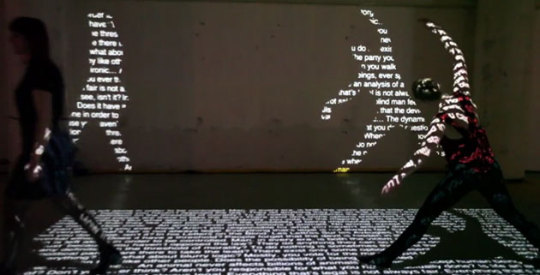In this blog I will explore and develop opinions of multimedia as an art form varying from it's use in art instillations to it's now common place on the theatre stage using history to inform myself. I will also take you through the journey of my own explorations and performances. Written by Crystal Quinney Barella.
Don't wanna be here? Send us removal request.
Text
FINAL SUMMARY
Following these weeks, I have not only learnt about the history of multimedia, the techniques used, and the different environments in which they can be applied but also pursued including them in my own work. These lessons will be applied throughout my future work as they not only influence use within multimedia but also in scenography, audience communication and participation and immersion. My own final piece, which can be followed with previous blog posts attempted and, I feel, succeeded in combing many of the applications multimedia can have.
My group and I particularly engaged with the use of audience interaction and integration between live and mediated. From the first use of media in art, such as Arrival of a Train at La Ciotat by The Lumière Brothers 1895, to mapped facial projection of modern day as performed by artists such as drag queen Sasha Velour and singer Lady Gaga; we see a phenomenal amount of development. This vast development means that its application has been recognised to contribute extensively to what we know as sophisticated and exciting art. In this final blog post I will address how we applied multimedia to our own established talents of performing and discuss the affect to which multimedia can and does revolutionise the theatre of today.
We relied on technology to a create and communicate our idea of demonstrating family memories via photographs. Due to the fact we had the audience dictate which scene they wanted, we had to seriously consider the layout of the space. I would argue this is an extremely important part of creating a multimedia performance. I realised this from an early stage when we used live feeds, such as setting up a camera elsewhere in the room. Other examples include projecting on to material on our body and showing pre-recorded videos in a live situation. All of these, when done well, are extremely advanced yet, because we are amateurs, we didn’t want to risk something like this going wrong in our final performance and wanted to marginally be in control. Through research I found that the set-up is crucial in creating an immersive performance. In Josephine Machon’s Immersive Theatres (2013) it is described that a ‘space envelops, becomes the envelope, container, casket of the experience’ and ‘metaphorically emplaces the interior landscape’ of the mind. This is key for our work as our aim was to allow the audience to become nostalgic, a very personal emotion within our minds.
Creating a work that was intermedial actually came relatively easily as we particularly specialise in live performance. With the help of our tutor, we were able to be apprised of many techniques in our work and so both ideas in live and mediated fused together quite often independently. Our idea for a live performance which included all of my group came early in the process and stayed reasonably the same throughout the weeks. We felt this would best demonstrate how we could practically showcase our knowledge of intermedial work. We wanted an equal distribution between the two forms so that the audience could be familiar with the piece but also interested by how they could influence it through the use of media. It should be mentioned at this point that although computer technology was not used in our model box and just solely torches and silhouettes were used, this additive was very much part of the mise en scène.
Mise en scène is ultimately the composition of the way in which you tell a story. It was important to us to be able to create a narrative whilst still handing over responsibility to the audience by which order they chose to select stories. Fluxus artist Dick Higgins said ‘intermedium poses a challenge to the separation of artistic media and embraces continuity over categorisation’ in Multimedia Performance (Rosemary Kilch and Edward Sheer, 2012), this suggests that when done successfully it is hard to decipher between both forms of art. So, in hindsight, I had hoped the audience would have selected all youth photos before moving on to the next section and going back to it as I feel that it would have created a better cohesion with all spectators and therefore would have been a more purposeful mise en scène.
Contextualising our performance, it is important to mention certain influences within our idea, a very notable one is Proust 1: Swanns Way which was an adaptation by Guy Cassier of Marcel Prousts work. It suggests ‘the way time and memory are staged through the use of digital video technology…calls for an intermedial approach’. Freda Chapple and Chiel Kattenbelt (Intermedality in Theatre and Performance, 2014) comment on how Proust recalls moments from his childhood…actors representing the mother and father carefully move their faces closer and closer to the camera thereby moving themselves into focus’. This approach is very similar to our work as we aimed to allow the audience to see a number of characters through just one live actor via the photo projected on the back. In this adaptation ‘the empty space functions as a platform’ - physically speaking we applied this in our piece. The audience had a separation with us in terms of being able to see a divide between the technology and our bodies but could relate them with each other simultaneously.
Reflecting critically on my performance and the journey of the module as a whole I feel I have learnt a number of techniques that I can bring forward with me, I particularly will take forward knowledge of projection mapping and apps such as Thicket, which I believe will be the future of intermediality. Audience interaction was key for me in creating a successful final performance as I think it allows the audience to fill the space and create a connection with the mediated and the live. Overall I am thoroughly pleased with my journey and will apply it in creating my own work in the future.
References:
Pg 136, Immersive Theatres – Intimacy and Immediacy in Contemporary Performance, Josephine Machon, Palgrave Macmillan, London, 2013
Pg 67, Intermediality in Theatre and Performance, Freda Chapple and Chiel Kattenbelt, Rodopi, New York, 2014
Pg 71, Multimedia Performance, Rosemary Kilch and Edward Scheer, Palgrave Macmillan, London, 2012
0 notes
Text
WEEK TEN AND ELEVEN
Week ten was our final ‘usual’ lesson before our dress/tech run next week. We spent much of this making sure we had everything in place. We have struggled with finding large sheets to project on to (this was surprising as I thought it would be simple and cheap) to get large enough sheets we aimed to get 3 super-king valance sheets I ordered these from a popular home store but cancelled my order during the same lesson because James suggested we use the shadow screens as they take far less time to set up and we had to be aware of this. We made sure we could have these reserved for the day. We also ‘blue-tac’t all of the pictures to the projection blocks to work out spacing and were satisfied with three collages on each side.
I also wrote up the job bag, the floor plan and tech requests. This took a lot of time as I wanted to make it completely clear how our piece would look and run.
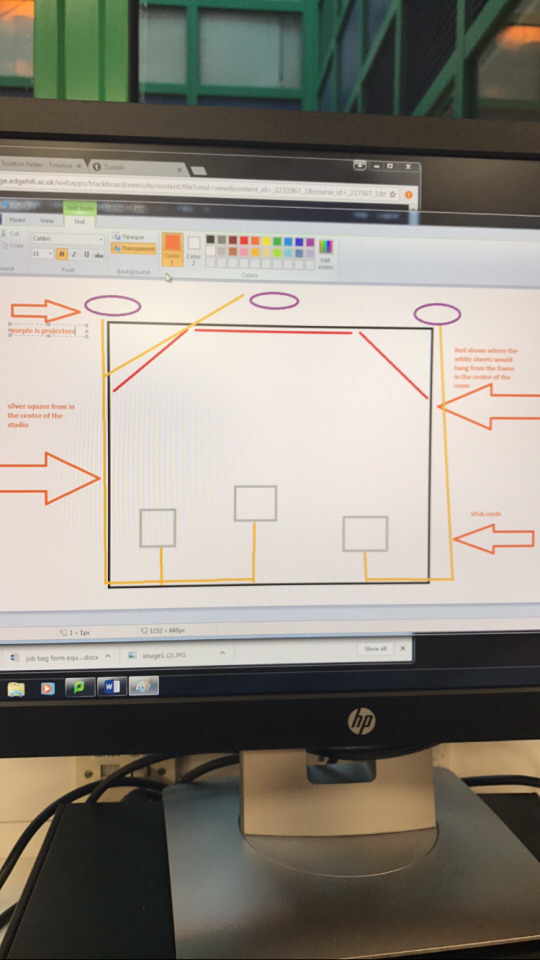
I now felt that we were fully prepared for the tech run because powerpoints have been successfully made and flow efficently and we have timed the scenes so that they will fill up a suitable about of time in our performance.
Week eleven was the tech run so we set the space out exactly how we will have it in the performance and ran it through, the biggest struggle that we faced during this process was trying to connect and correctly position the VGA cables from the laptops at the front to the projector at the back of the shadow screen. We thought that we had to connect a male end to a female end using around 20, 1 metre cords, we then found there were extra long ones made anyway so had to pull them all apart and re-lay the long ones. It was worth finding them though as it means in our final performance we can use just 3 long ones, saving lot of time.
My class mate had collected a number of nostalgic songs from us all and comprised them in Garage Band and so the long track accompanied our performance. This was effective because our performance was majorly a mime with just the odd exclamation. Here is a picture from the front (with my funny face) showing how the room will be laid out.
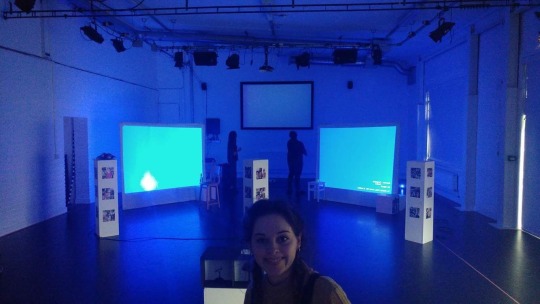
In the final performance we will use actual stands to hold up the shadow screens and not chairs and blocks, we just did not have all four available to us at the time.
Before the final performance we must gather all the props, in my case I need a large grey coat, a beak, a wallet and a chair for my scenes. These will be used not only in the scenes but for the rest of the performers when they are not acting out their own scene. For example we will switch places and replicate common habits throughout times in your life, this can be something as simple as playing in childhood, being on your phone in early adulthood and reading in later life.
My whole group is very excited and we feel prepared now.
0 notes
Text
WEEK NINE
We had a break from our final project for the majority of this weeks lesson!
We watched two videos of a fantastic drag performer who uses projection to distort the audience and place them even further into an illusion. The queen was called Sasha Velour and we watched her performance of Cellophane and This Womans Work you can watch both of the performances here:
https://www.youtube.com/watch?v=I0S7-iKzEBE
https://www.youtube.com/watch?v=mIm9mp5eiVs
As we understood we were set the task of incorporating projection into moving performance. We took inspiration of the drawing on the body from Sashas performance and wanted to recreate that. We first thought of creating a cape-like piece of clothing that could be worn over the arms and then when lifted up would show a number of arms underneath it like a Hindu god. However we realised this would show up behind me once my arms had moved down. We liked this theme of god-like patterns and then continued with the idea of a Mandala. I have an app on my phone called Fx Symmetry and we used that to create Mandalas that were projected onto my body. This was done via connecting my phone to a lead which in turn connected to a HDMI which was attached to the projector.
This app also allowed you to draw without making it symmetrical so we then thought it would be interesting (and funny) to draw simple faces of the sheet covering my head and then I would mellow-dramatically act out the emotions such as shaking and tensing when my face looked nervous etc.
Matthew, a member of my group then realised on the app that would could change the colour and thickness of what you were drawing with and through pure accident drew a thick red line up the length of my body as I moved my arm upwards. It looked as if I had controlled it. We then proceeded to continue this small section by small section until I had drawn myself a dress. Another member of my group mentioned that I looked like Marilyn Monroe. Going further with this idea we played the song Diamonds are a girls best friend whilst I seductively re-did the routine of drawing my dress adding a few girly smirks and eye rolls.
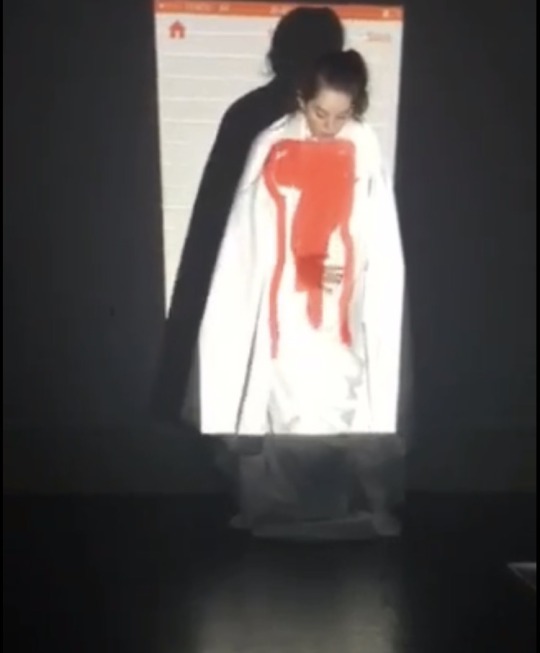
We presented all of these ideas in class and reflected on them after. We noticed with all of them that it just takes a long time to be able to control exactly where a projection goes and slowing down is the best thing you are able to do.
After the workshop finished, me and another member of my group went to the library to finish the collages and print them off and the other two members went to the design rooms to create and finalise the model box of the tree cycle. I layed them on the blocks and thought they looked well spaced and after visiting the other two in the design room they had come far with the box by stenciling and cutting out the foam board. See picture below:
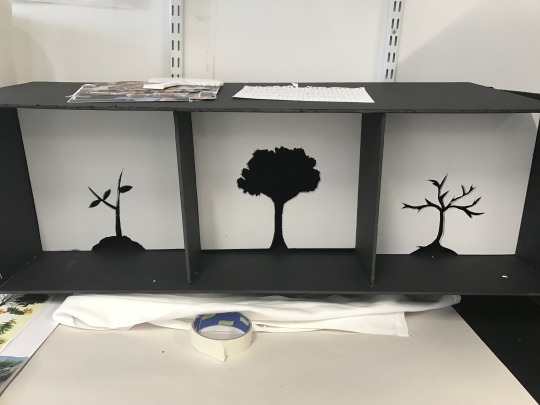
Now we have finished the majority of the physical objects next week we aim to rehearse our scenes and create the power points for the audience to select from as well as create an equipment log and request help for setting up.
0 notes
Text
WEEK EIGHT
This week was spent in the library with two of the members of my group. However at the very beginning ofthe lesson we went into Ormskirk town to buy a white sheet We attempted to use the mesh material we already had and then tried the white screen but nothing seemed to get our desired affect. Therefore we actually bough a super-king mattress cover to experient with, this seemed as though it would work well and so we aim to buy 2 more.
The 3 hours we spent in the library were collecting photos to put together to make the memory boxes. These are the most time consuming elements of our piece as we have had to take pictures of scrapbooks, documents and photo albums etc, crop them, sort them into 3 separate piles (one for youth, one for adulthood and one for later adulthood) and then put them into collages. Although we amounted hundreds of photos we realised that it still wouldn’t cover the entirety of our blocks so decided it best to print newspaper articles from important dates in our life. An important date for me is the day my sisters were born which was 10/5/2011, therefore I would find news articles from that date, we believe it shows a connection between our own personal life and what everyone else in the world is aware of at the same time.
I began creating the childhood collages by saving every childhood picture to my phone and using an app called Layout which allowed me to put up to 9 photos in one image, here is an example of a collage of mine:
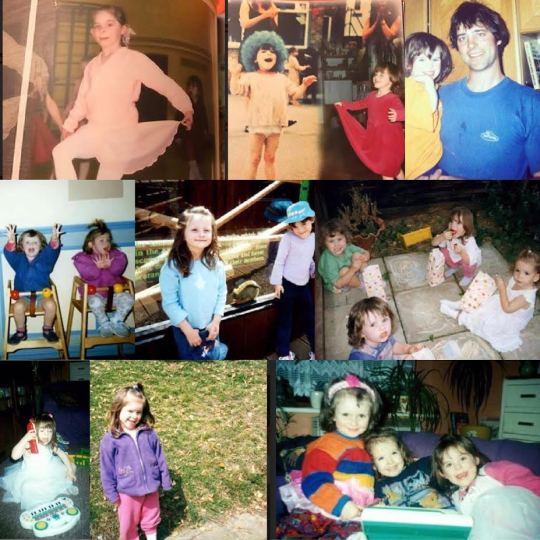
We aimed for 12 collages per stage of life. I finished childhood and had done a few adulthood ones before the lesson finished. One member of my group also began on later adulthood. The aim for next week was to finish the collages mount them to the blocks and finalise the model box which shows different stages of a tree showing a simplified version of the cycle of life.
1 note
·
View note
Text
WEEK SEVEN
The majority of this weeks lesson was spent creating a powerpoint through which we could elaborate of our planned performance. The set out consisted of:
-Our idea
-Elements of our idea including: memory blocks, the tree, small simplified box, live performers and separations between selected areas.
-Design of stage: projection mapping, audience, live segments
-What we have done and what we will do research wise
-Our aim and audience response.
Further detail of our plans can be seen in my post of Week Five and Six.
We developed our idea further this week by deciding to use audience participation via technology such as a laptop or tablet. By putting a select few pictures on the screen for them to choose from and then recreating the actual situation in which those photos were taking. This would give the audience a further connection to our own lives and make links to theirs too. This would be done by projecting their selected picture (they would have four to choose from) onto the screen behind us and performing in front of it. There would be no effect of the image, such as shadow and the as it would be a back projection (see the logistics again in Week Five and Six.
As mentioned in earlier posts, each person in my company (four in total) have a vast amount of photos which we have amounted through our own lives and our families. However, as mentioned, we had to narrow these down to an option from each of us on each phase of life. There are 3 phases of life and one picture in each, therefore we must pick one from youth, one from early adulthood and one from later adulthood. Theses are the pictures I chose:
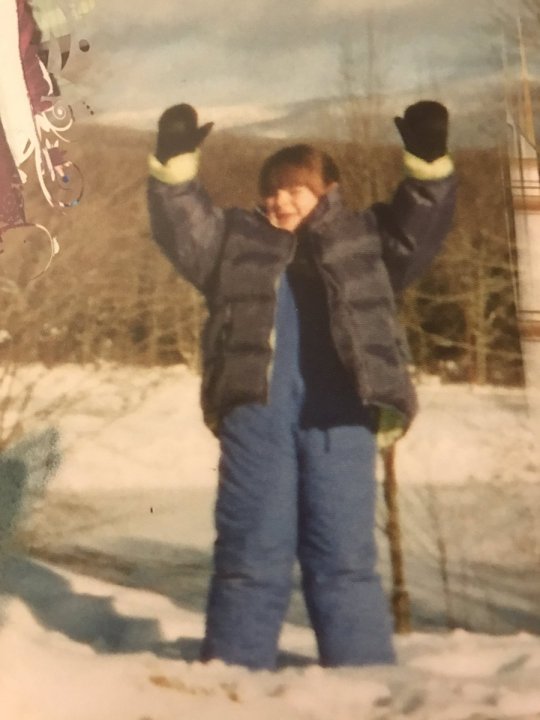
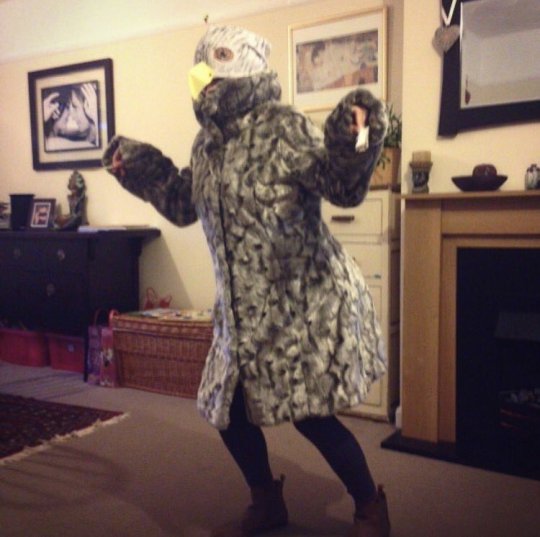

These are the stories I will recreate and the stories are the following:
Youth: This is a picture from my first (and only) time skiing. It was in New York and I was 6 years old. This picture was taken after I had just jumped of a ski lift to ski straight down a blue slope. I held hands with someone to begin with but then let go and skied by myself to the bottom. My mum was at the bottom cheering me on and as she shouted ‘you did that all by yourself! I face planted spectacularly. She was quite obviously in stitches.
Early adulthood: This if you cannot tell is me dressed as Buckbeak the Hippogriff from Harry Potter and the Prisoner of Azkaban. It was for a Harry Potter themed fancy dress birthday party. HOWEVER, I was the only one that turned up in fancy dress. I say that, the odd girl has a cat painted on their face with eyeliner, hardly distinctly Harry Potter excusing Mrs Norris. They all look at me as if i was a complete nutter considering I turned up to the party by myself. I won the fancy dress.
Later adulthood: I obviously have not myself experienced later adulthood but I was there to experience this moment with my grandad (who was the greatest man to ever exist). We went to Spain a few times, one of these times I was swimming and shouted for my grandad to come in too. Without hesitation trails blazing he joined me, it wasn’t until about two minutes later he realised his wallet was still in his trunks. He got out and spent the whole afternoon laying his wallet out note by note on the concrete trying to dry them off (theres a lot of stuff in a grandads wallet).
These three stories are special to me and so these are the ones I will recreate. These will be created by Week Eights lesson.
0 notes
Text
WEEK FIVE AND SIX
POSTED 21-02-2017
The lesson on the 16th of February took place in a design room where we had a short meeting about designing, formulating and presenting our final piece, me and three others are still sure of our idea about life and the journey through it. These ideas are discussed at the end of the blog entry on week three. So therefore we wanted to build on it.
James asked each group to use black foam board, scalpels, rulers and a hot glue gun to create a rectangular shape that can be used as part of our performance. Whether this be a whole scale demonstration of what we are going to do or a small instillation to be used in the piece was up to us. My group decided to do both and we created a simplified version of our whole piece to put at the front of the performance space in our final piece.
We created a long box with two divides in it creating three sections. These three sections represent, birth (and the surrounding years) life (growing into it/ adolescence), death (older life/memories). We feel it would be interesting to represent these stages as trees so we have come to the decision on using projection mapping to show different images. We are able to just use one mini projector to be able to cover the whole of the box because of the used of projection mapping on a tablet. Here is a visual representation of what I mean:
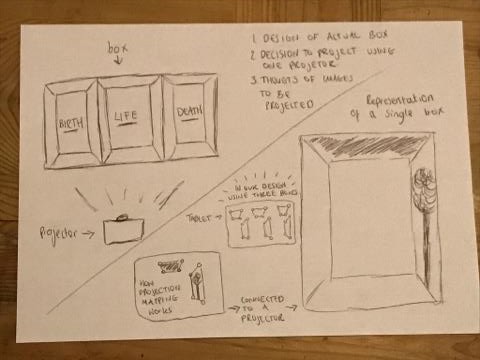
We completed this task relatively quickly as we already knew to an extent how we wanted to stage our piece. Therefore, after we had set the box on the side for the hot glue to dry we began thinking about the large scale version of our piece and wanted to lay it out the same as the box in three section. However, we later decided that the walls on the large scale in the middle would block the view for spectators on the other side of the room and therefore wanted to create a barrier without physicality. We decided on using three projectors sequentially in order to divert the audiences attention to different areas of the room when certain parts we being presented. This meant that we could still have three sections without walls having to be put in. This was also due to the fact we would have 15 minutes to prepare the space in our final piece and it wouldn’t be feasible to have such large pieces in the space that took a long time to set up.
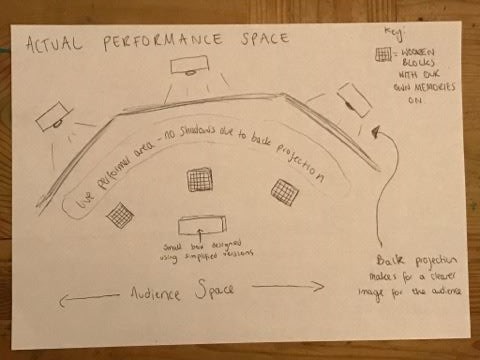
Because we decided against the walls, which we were going to put our own personal memories on (like the walls of a bedroom), we decided to put them on white projector blocks instead so the could be viewed from all angles. James showed us a previous students work of a sign which had been covered in scanned images of memorable events in her life such as her baby scans, her parents death certificates, letters, photos etc. This was very inspirational to us and we decided that over reading week we would make a collection of all of our own memories and see if we were able to collect things from other generations too.
It is now reading week, week six, and I have found a number of things that represent my own life and are memorable symbols of everyones life as a whole. I will print/scan these and many more when we return after reading week. We will all bring our collections together and begin to collage them onto the white wooden blocks.
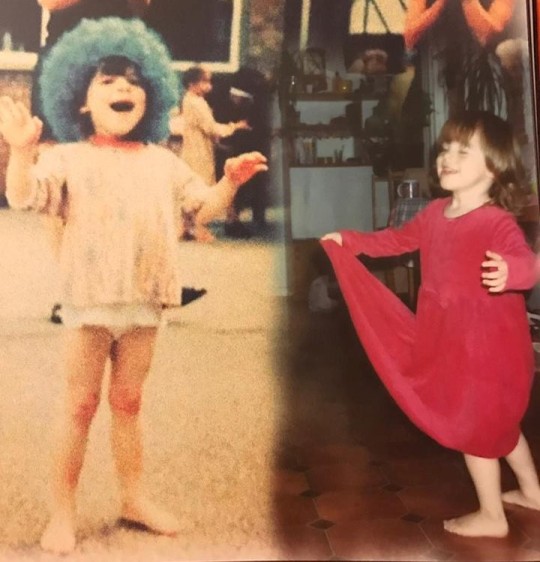

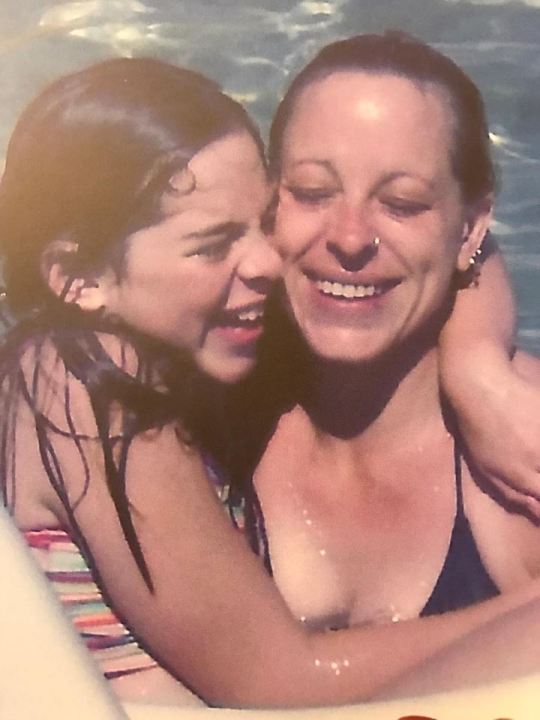
0 notes
Video
tumblr
A short segment of our whole class piece (the shoal of fish).
0 notes
Text
WEEK FOUR
POSTED 21-02-2017
Later update than previously (I’ll be making two posts this week). This week was probably the most exciting and explorative yet. It was a whole class project using lots of material, mesh and silky textures, rope, white blocks etc. We had a very large studio space in which we could create whatever we wanted for an audience to interact with. We had a lot of ideas to begin with such as using a live feed with projections one above the other and using alternate cameras to capture someone walking on the ground level and projecting it in the image above. However, before this idea had been properly formulated, other students had already set their ideas on creating the space by tying rope in a zig-zag shape and hanging the mesh-style fabric on it. See below:
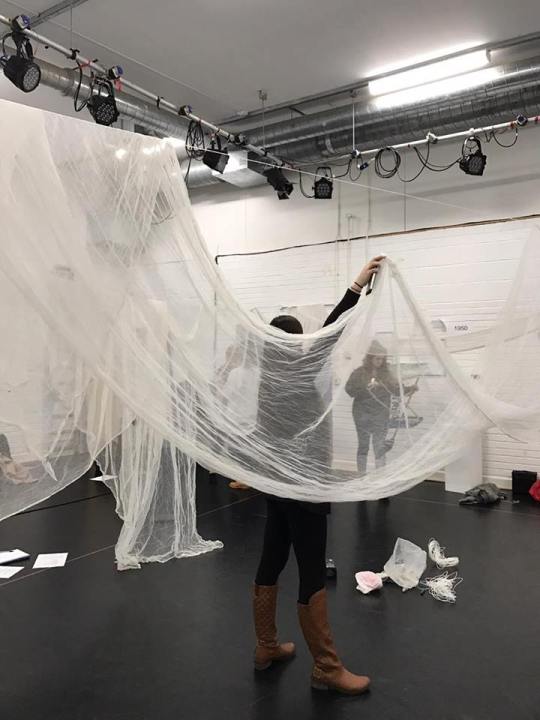
From last year we had seen that you can create lots of interesting textures and projections from throwing an image at layers of material. James (my tutor) showed us apps that he had on his tablet which enabled us to experiment with what could be shown, these apps included Thicket and Optoma Projection Mapper. I will download both of these myself. Thicket created noise/music from interaction with the screen which was projected onto the surfaces and Optoma mapped certain images onto a particular space (see second and third photo):

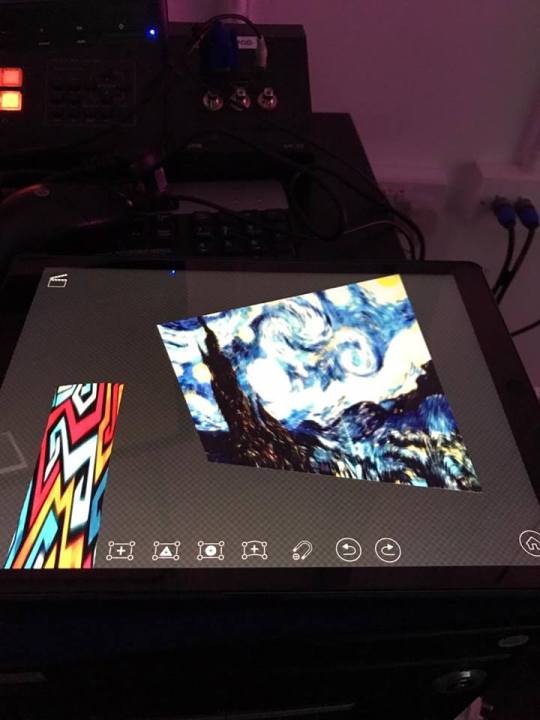
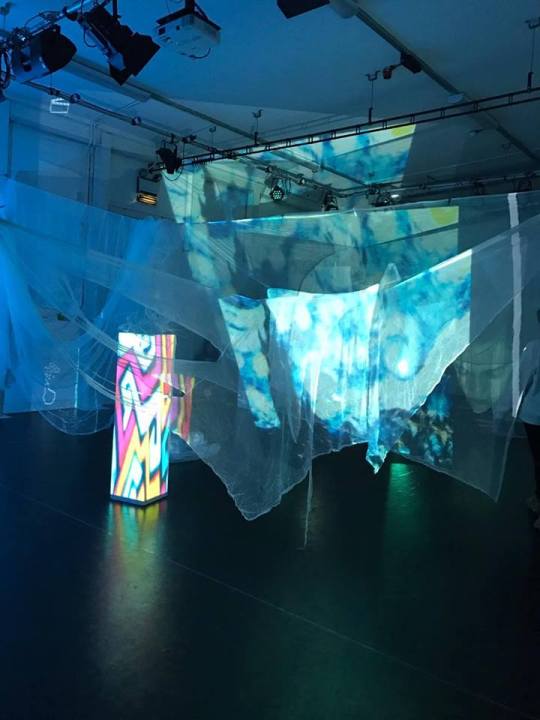
We attempted to create stations by which the audience or spectator could view, appreciate and move on to another. We had a stream of Loie Fuller’s Serpentine Dance on loop projected in a space on one flat wall. We also created a place in which the audience could be part of the projections by putting a seat down in front of a camera that was linked to a live projector. I particularly liked this area of the room because the projection was shown on layered material which meant if the participant moved there could be some kind of distortion which fitted directly with the main theme of this instillation.

Our main theme was inspired by the story of Alice In Wonderland and we looked up the original story and listened to one student read it whilst we listened. The most interesting part of this exercise was the he used a loop pedal repeating and emphasising parts he thought was important. A group of about 6 of us decided to react to what he was saying along with what James was creating on Thicket and felt the best way to convey the power of it was to stick together like a shoal of fish. We moved around the space following the person at the front of the shoal and then broke off into our own to demonstrate the way the words personally affected us. Due to the fact we moved our own bodies through the spaces we felt as though the spectator would feel encouraged to do the same.
Please see the next post to watch a short video of our piece which lasted around 10 minutes.
I personally really enjoyed the compilation of all of these elements within the space as it showed a diverse range of what you could do with multimedia. If we were to re-do it The only thing I perhaps would have changed is the design of the space as I felt that we tended to hang the material up without thinking about how it could be used. If the space had been designed better, for example with more divides or perhaps less that were much bigger we could have explored different types of media and perhaps had more room for the spectator to interact.
0 notes
Text
WEEK THREE
POSTED 7-02-2017
This week differed from the others as we ventured out of the studio to the Tate Liverpool.
The Tate Liverpool is a fantastic day out by itself (I recommend going even if you aren’t ‘artsy’) but it was particularly fascinating on this day as a new exhibition is being shown on the ground level of the building. An exhibition that is both bewildering and curious.
The piece shown was called Sprung A Leak by Célcile B. Evans. It was a play performed by robots (will they put me out my job?) Here is a better description of it;
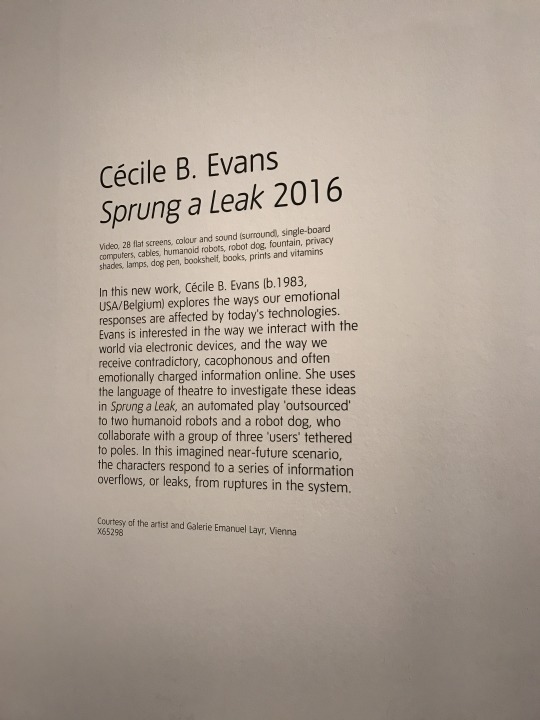
The robots read signals that were attached to the beams in the space, you will be able to see them in another picture I attach. Makes it slightly less freaky when you realise that without the instructions they couldn’t really complete any task! These robots, along with the mechanic movements of the pole dancers (again these will be shown) and the televisions dotted around the room made for an extremely futuristic ‘new-world’ style of performance. The screens replicated to an extent what was being said in the script. The play was set out as three acts and each act featured a number of different movements from the robot, exclamations and images shown through the screen.
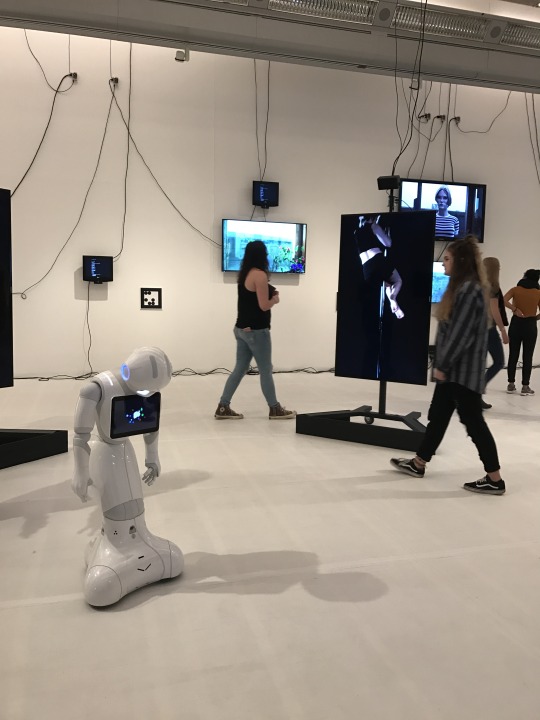
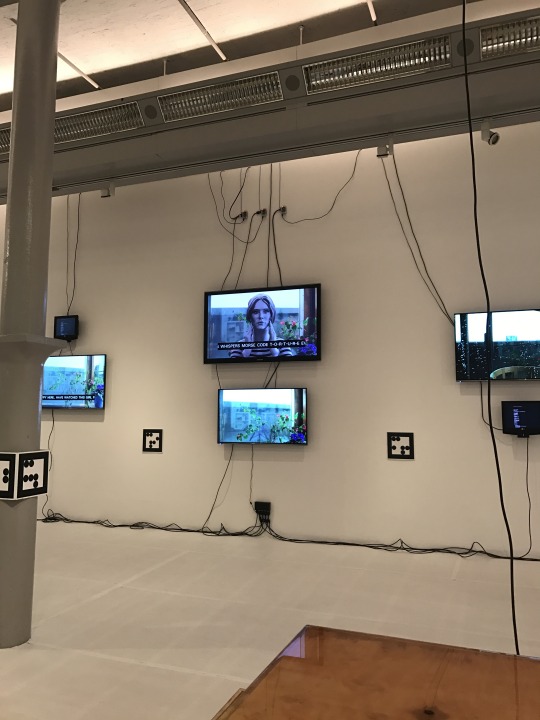
THINGS I NOTED FROM THE EXHIBITION:
-FOUNTAIN: I haven’t mentioned yet (however you can see the corner of it in the bottom right hand corner of the last picture), the fact that there was a ginormous wooden fountain located in the space on the right hand side of the room. It was quite bizarre to see a natural material within such a man-made, futuristic environment, when it erupted in the first and second act it became the most shocking thing of the whole piece (which is saying something when theres robots in the room)!
-SCREENS: I also realised that almost all of the images on the screens were of nature, it was refreshing in what felt like such a clinical environment. For me it gave an appreciation to what we already have around us, and noticing the complexity of nature being far bigger than the complexity of a man made object.
-BLOCKED ROBOTS: This follows on from my last statement and elaborates on what I said before, as you can see in the bottom picture, located on the walls and beams are what we effectively know as co-ordinates. This is how the robots found their way round, when me and my class were in the space (10 of us, excluding the tutor and a few other people) it was hard for the instructions not to be blocked at certain times. This lead the robots searching in another direction. This made me think of other ways this could be performed, perhaps including people. For example, performers could wear these co-ordinates on their clothes and see how the robots reacted to that. Now all I need is a large white space, the most advanced robots in the world, a large commission and a company of artists.
Final Thoughts..
After walking around the rest of the Tate Liverpool which featured Glenn Ligon, William Blake and Tracey Emin’s work we gathered in the cafe to discuss our ideas for our own pieces. I liked the idea of life, (birth, death, rebirth, etc) and questioned projecting live animation. I thought of when I was in school and the teacher wrote on the transparent film of the projector and how this could directly be used with my idea. I will continue with this idea and how it can be used without looking amateur and with conviction.
0 notes
Photo
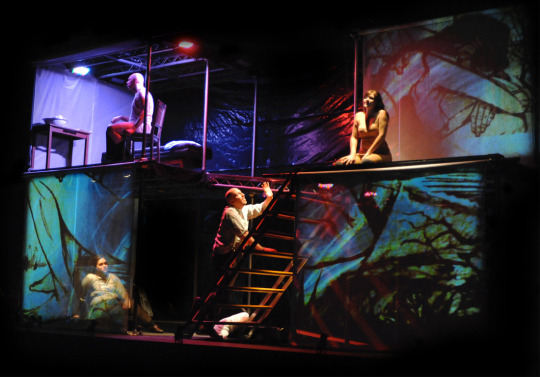
I like the depth that these projections create. It reminds me of my own experiments with the blocks in the projections during class. Depth adds more realism to theatre.
0 notes
Text
WEEK TWO
POSTED 31-01-2017
Reflecting on mixed reality, intermediality and my own trip to the Tate Modern London.
Before I start my reflection on my lesson this week I feel it fitting to mention that the weekend just been I went to London to watch musical ‘Stomp’. It was amazing, however I will be talking about the day before ‘Stomp’ in which I visited the Tate Modern with my mum. There was a large part of the museum dedicated to interaction with multimedia and technology (how fitting)!
There were many exhibitions with both artists I had studied and artists whom I have never heard the name of. These included, Kazuo Shiraga, Jesus Rafael Soto and Otobong Nkanga. All of which had displays which you were not able to hear unless you stood in an exact spot in the room. This is one to one communication and really fasciated me as it was hard to connect to any of the work without being the person in the particular spot.
Furthermore, as mentioned I saw work from artists I already knew such as Nam June Paik. I studied his work last year in my first year of university. He was/is part of the Fluxus movement, a movement which can be described as ‘anti-commercial’ and ‘anti-art’ with neo-dada influence. I won’t give a life history but he uses television often or rather his art through a monitor. One of his pieces will be shown in a picture below. It is an egg being filmed and played onto a monitor with the second monitor hollow and filled with a physical egg. It demonstrates mixed reality and intemediality perfectly. It suggests that although what we see on tv is filmed realistically it is artificial. Because the physical egg is behind the monitor you can compare the two types of reality. It really makes the viewer question what it means for a performance to be mixed reality.

Anyway, my lesson this week...
We questioned what Mixed Reality is. To me it is a performance or instillation that makes the viewer question what is genuine and what contribution it has towards a final aim. We explored this in our 4 hour class.
We used cameras, a studio space, a projector and eventually some large white boxes to create a live, intermediated performance. To begin, we experimented with taking photos and filming short clips of ourselves in the studio space and showed those clips and pictures through the projector into the space whilst being in it. We attempted to project exactly over our live selves. This was hard work but we managed to an it almost looked quite ‘Purge’ like.
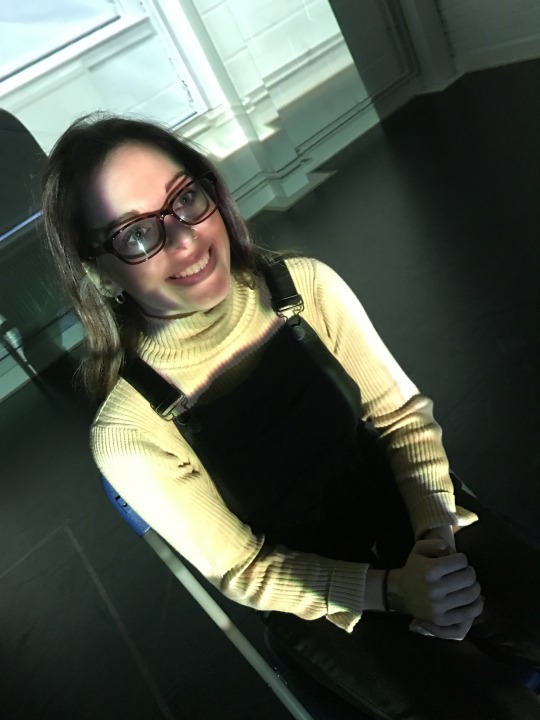
Then the people I worked with and I combined with the other group in the class to share stories from our childhood. We were set the task to be able to interact with each others story via projection. We pre-recorded the stories and then had a live person walk through the space. They’re movement prompted the stories to follow on and the piece would have not made sense had it not been for the combination of live and mediated.
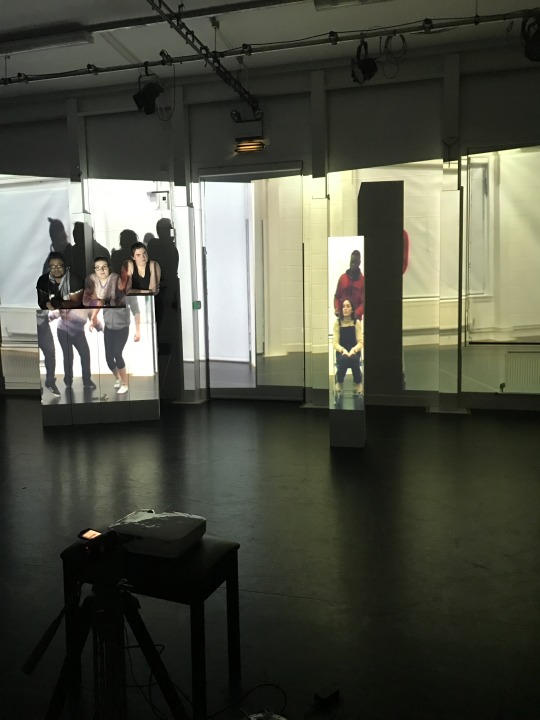
Intermediality and and Mixed Reality, for me, is probably the most interesting form of multimedia as it shows our progression with technology and how it can enhance an idea put forward by the reliance on media.
Some interesting examples of intermediality and mixed reality are:
JET LAG: PART ONE: ROGER DEARBORN by The Builders Association in collaboration with Diller and Scofido
THE ELEPHANT VANISHES by Complicté and Setagaya Theatre of Tokyo
PROUST 1: SWANN’S WAY by Marcel Proust
all of which show an interaction to a technological performance as well as being live in the space also.
I look forward to exploring intermediality, mixed reality and furthermore interactivity in the future.
0 notes
Text
WEEK ONE
.POSTED 24-1-2017
Reflecting on the first session and focusing on a case study.
After being introduced to Multimedia last year I was excited to start this year as in the future I would like to use it in my own work. I find the way we are able to manipulate technology in the modern day makes it impossible to put any boundaries on it. Due to the fact we are living in a technological revolution, in the future we will be able to do things we cannot even dream now. This is why, as an artist, I see the study of multimedia in performance as crucial.
In the first session we created a timeline of Multimedia being used in Art throughout history and found studies as far back as 1891 in which Loie Fuller created the Serpentine Dance Projecting on to her flowing gown in a multitude of colours. We continued to find examples all the way up into this year, which, being only one month in, shows that it is becoming a popular and sought after type of art form.
All examples related to one or more of the following types of multimedia performance;
-INTERGRATION, the mediated and the live
-INTERACTIVITY, spectator and performers within structures
-REMEDIATION, work across/through different media types
-IMMERSION, spectator within sensory experience
-COMPOSITION, non-linear narrative
As the weeks continue I will explore what each one entails, how they can be used and to what affect.
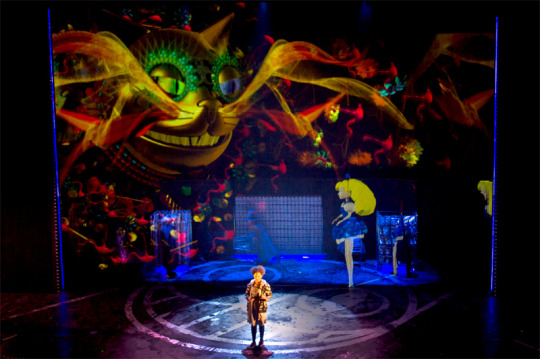
At this point I find it suitable to talk about my own case study which specialises in Immersion, a type of theatre I am particularly facinated by. Wonder.land created by Damon Albarn, Moira Buffini and Rufus Norris in 2016 is a musical inspired by Alice In Wonderland, a story which many know well. However, it features mobile phones by which the main character finds an online game where people listen and understand her. She meets many digital personas and the soundtrack features jittery electronic beats therefore the audience almost feels as though it is futuristic rather than modern. Projections, holograms, interaction with technology and VR headsets which the audience are able to use all contribute to a very big re-vamp to what we know as the traditional story. Furthermore they take the idea of a musical which in some opinions could be classed as staged, cheesy and predictable into a revolutionary piece of theatre by relating what we are beginning to see around us to a story from generations before us.
Here is the trailer: https://www.youtube.com/watch?v=mVhWUlJKxog
0 notes
